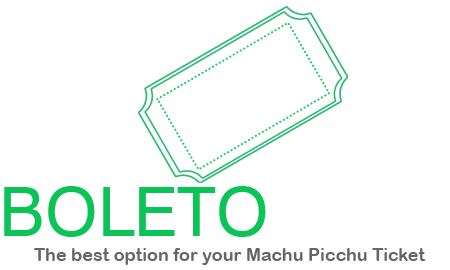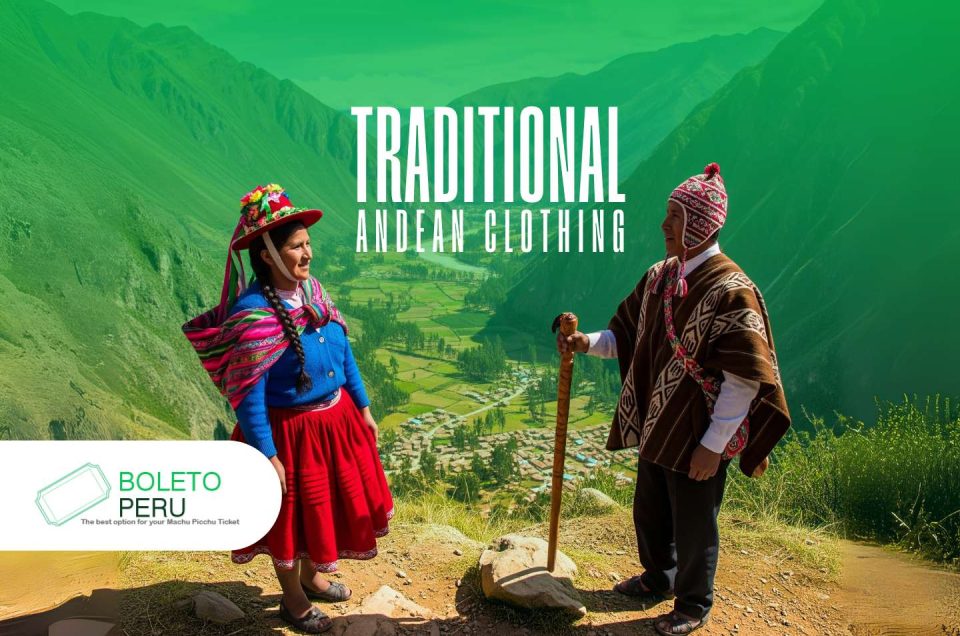The traditional Andean clothing of Peru is much more than a garment: it represents history, identity and culture. Over time, Andean communities have used clothing as protection against the diverse climates of the highlands and the altiplano, but also as a means of expressing belonging, beliefs, and a connection with nature.
The colorful fabrics with unique designs convey the meaning of a culture that has lived in Peru for thousands of years. Ponchos, chullos, polleras, and llicllas, made with alpaca, llama, or vicuña fibers, stand out for their quality and warmth. In addition, many include geometric patterns and symbols sewn into their fabrics, which tell stories and traditions of the native peoples. The traditional Peruvian clothing is, therefore, a reflection of the country’s cultural diversity and a palpable example of the ancestral legacy of the Andes.
About traditional Peruvian clothing
Clothing in ancient Peru reflected the cultural and geographical diversity of the country. Each region adapted their clothes to the conditions of the environment, while also conveying identity and beliefs through materials, colors, and designs. Below, a look at how the populations dressed on the coast, in the highlands, and in the jungle:
- Coast: On the coastal strip, cotton was the main material. Women used to wear loose blouses and long skirts, while men wore light shirts and pants. Light colors and prints with floral designs were very common, suitable for the warm, dry climate.
- Highlands: In the Andean region, sheep, alpaca, and vicuña wool was essential to resist low temperatures. Ponchos, chullos, and blankets were part of the daily attire for both men and women. The fabrics were known for intense colors and geometric designs, which also conveyed symbols and traditions of the Andean peoples.
- Jungle: In the Amazon, the humidity and heat required cool and light garments. Women used to wear long tunics or simple dresses, while men chose loincloths or short pants. Earth colors and designs inspired by the flora and fauna were common in the decoration of their clothing.

Practical function of traditional clothing
Traditional Peruvian clothing not only stands out for its vibrant colors and characteristic designs, but also meets the basic needs of the communities: providing protection and expressing identity.
- Protection: Each garment was created with the region’s climate conditions in mind. On the coast, light and loose cotton clothes helped to cope with the heat, while in the Andes, as in Cusco, ponchos and chullos woven from wool offered essential warmth against the low temperatures of the highlands.
- Identity: Traditional clothing also played a social role. The colors, patterns, and accessories served to show the place of origin, social position, or even religious beliefs, becoming a visual language that distinguished each community.
The Traditional Clothing of the Inca Culture
History of Inca clothing
Inca clothing was closely linked to the geographic environment and the social organization of the empire. According to the altitude and the climate, the garments fulfilled practical functions: on the coast the use of cotton was dominant because of its freshness, while in the Andean regions llama, alpaca or vicuña wool was mainly used to protect from the cold. Thanks to trade between different zones, both materials circulated widely, which allowed the Incas to have cotton and wool in most of their territories.
The clothing also reflected the social position. Common men used to wear simple tunics that reached above the knee, accompanied by sandals made of grass, wool, or leather. Women, on the other hand, wore long skirts to their ankles, held with braided belts, besides covering their hair with a cloth sash and, in many cases, hats. In the higher status sectors, the garments were distinguished by the quality of the fabrics, the use of natural dyes, and the incorporation of symbols that reinforced their power and prestige within Inca society.
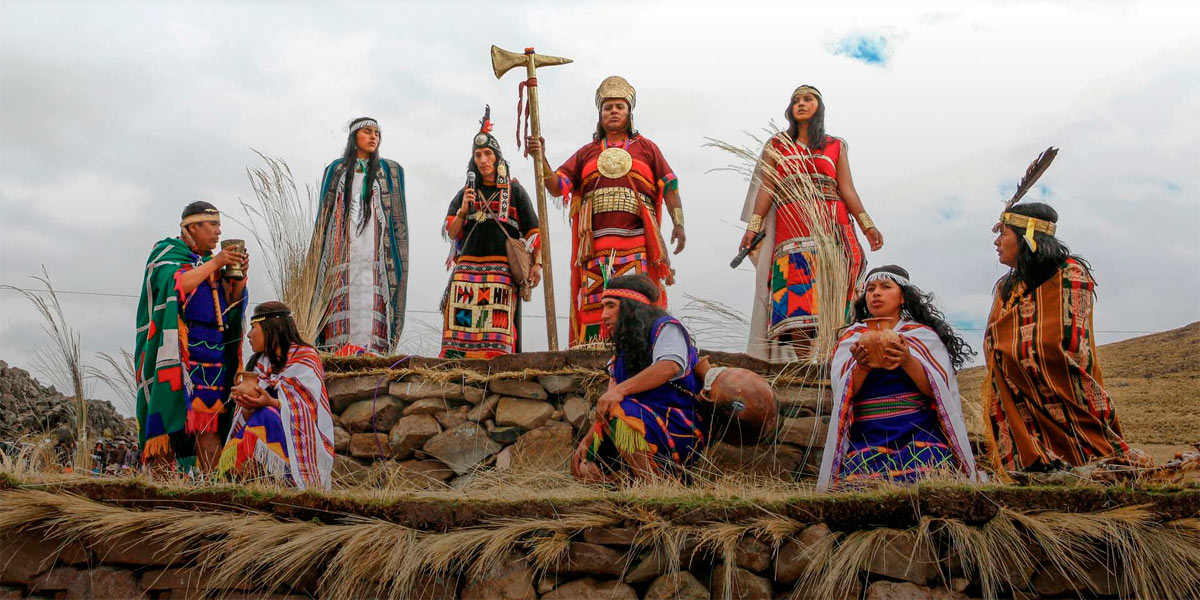
The attire of the Inca Emperor
The Sapa Inca, the highest authority of the Inca Empire, used an outfit that reflected his political, spiritual, and military power. His clothing was made with the finest materials, especially vicuña wool, considered a sacred fabric reserved for the elite. The garments were made by the Acllas or “chosen women”, specialists in weaving and making clothes for the nobility and the gods.
The imperial attire included:
- Unku: a long and wide tunic decorated with geometric designs (tocapus) that symbolized power and prestige.
- Topayo: a wide sash that cinched the waist.
- Llautu: a turban with multicolored folds adorned with a stripe of scarlet tassels and erect feathers, a unique insignia of the Sapa Inca.
- Royal headdress: with golden fringes and feathers from different birds, which distinguished him from any other member of society.
- Coat and jewelry: pieces ornamented with turquoises, gold, and precious stones. He wore heavy shoulder pads, bracelets, and large gold earplugs.
- Footwear: sandals or shoes made of fine leather and skin.
- Sacred insignias: he carried a shield with the image of the sun god, Inti, and an insignia decorated with hummingbird feathers framed in gold, supreme symbols of his divine connection.
Inca nobility clothing
The Inca nobility was made up of the Sapa Inca’s close relatives, including blood relatives, in-laws, wives, and children. Their clothing was luxurious and varied, although it did not reach the emperor’s level. Their garments were made with the finest wool, dyed with bright colors, and adorned with details of gold and precious stones.
The nobles also wore the llautu, a status headband, decorated with a fringe of tassels. They had unique privileges, such as wearing feathers from birds considered sacred: the corequenque (a bird of prey from the Andes) or the mountain caracara. On occasion, they could even wear garments made with their feathers, although these elements were strictly reserved for the royal circle.
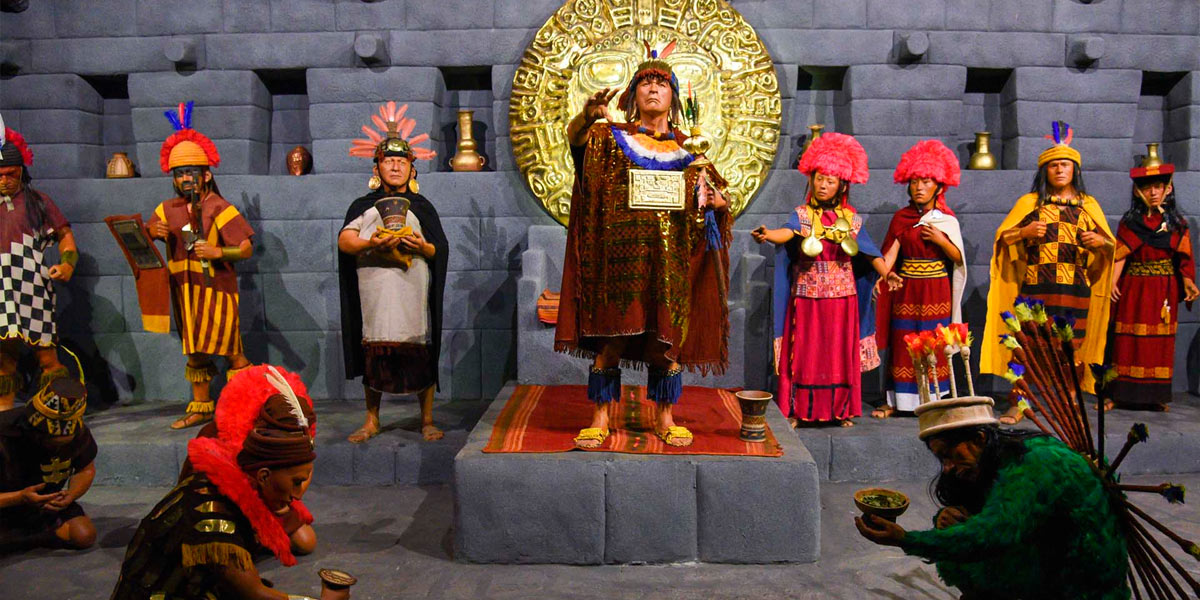
Body adornments
Inca leaders, priests, and warriors used body paint on their faces, arms, and legs as a symbol of rank and distinction. The emperor, in particular, wore hats woven with gold and wool tassels, frequently crowned with striking feathers.
High-ranking men complemented their clothing with feather adornments, such as headdresses that evolved into crowns, hanging necklaces, and pectorals. The wealthiest Incas wore heavy gold and silver accessories: large pendants on the chest, discs in the hair, inlays on shoes, and bands on arms and wrists.
Traditional Andean Clothing
Each nation keeps its own identity reflected in its music, dances, farm work, fishing, and, in a very special way, in its clothing. In the case of Peru, traditional Andean clothing is not simply an outfit, but a cultural legacy passed down from generation to generation. These garments express history, symbolism, and the relationship of the Andean people with their environment.
A great example is the chullo, a hand-knitted wool hat with ear flaps, and the poncho, an outer garment that protects from the cold and rain. Both have become true symbols of Peruvian culture, recognized both nationally and internationally.
Next, some of the most representative garments used by men and women in the Andean region are described:
Typical Peruvian Clothing for Women
Traditional female clothing in the Peruvian Andes is full of color, symbolism, and function. Each garment reflects both cultural identity and daily life in the Andean communities. Among the most representative are:
- Lliclla: A hand-woven cape that covers the back and shoulders. It is fastened in the front with a metal pin called a tupu. Besides providing warmth, it is used to carry children on the back and transport objects, so it is a versatile garment used by both women and men.
- Chumpi: A traditional sash or belt whose name in Quechua means “belt.” On women, it is used to adjust the skirt or hold babies, while on men it is used to hold up pants or support loads.
- Jobona: A wool jacket worn under the lliclla. It is decorated with colored buttons and provides warmth in cold climates.
- Monteras: Hats made of stiff fabric, with a round or rectangular shape, that are adjusted with a woven strap called Sanq’apa, decorated with white beads. Each region gives them a particular style.
- Polleras: Wide skirts made with sheep or alpaca wool. They are usually thick, pleated, and decorated with a colorful band called a puyto. They represent one of the most characteristic garments of traditional Andean women’s clothing.
- Ojotas: Traditional sandals known in Quechua as usuta or ushuta. They are made with a leather or plant fiber sole and have three straps: two hold the heel and one passes between the big toe and index finger.
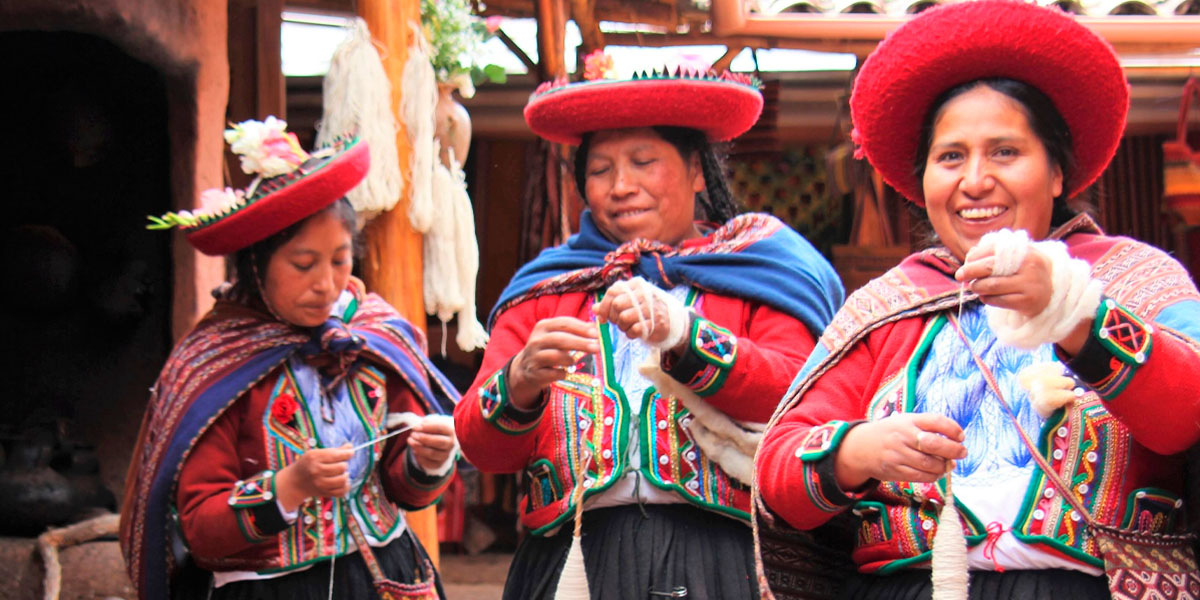
Typical Peruvian Clothing for Men
Andean male clothing also stands out for its colors, weaves, and for being adapted to the harsh climate conditions of the highlands. Among its main garments are:
- Poncho: One of the oldest and most emblematic pieces. It is made with alpaca wool and consists of a folded or two-piece fabric that is used to cover the body and protect from the cold.
- Chullo: The famous Andean hat with ear flaps, woven with sheep, alpaca, or llama wool. Its colors and designs vary by region, reflecting local customs and inherited traditions.
- Chumpi: A wool sash used to adjust clothing at the waist, support loads, or protect the lower back.
- Ojotas: Just as with women, they are the most common footwear in Andean rural areas, made with leather or plant fiber since pre-Inca times.

